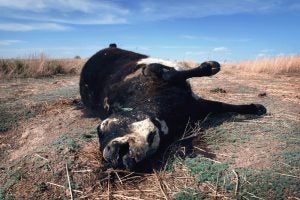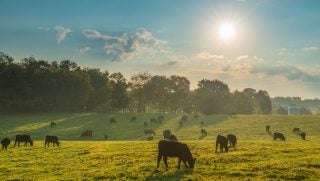Cattle likely won’t be culled by U.S. Forest Service aerial gunning next year in the Gila National Forest in New Mexico.
After the contentious shootings of estray cattle in the Gila Wilderness in 2022 and 2023 that drew attention from state officials, including New Mexico Gov. Michelle Lujan Grisham, federal officials finally said that the aerial operations may not be necessary because of the small herd that remains.
The New Mexico Cattle Growers’ Association joined with other groups in a lawsuit seeking a permanent stop to the aerial gunning of cattle in the Gila. The federal judge agreed to postpone the hearing until February — a rescheduled date for the motion hearing has not yet been set.
“Forest Service estimates that the number of remaining Gila Cattle is roughly in the neighborhood of 10-20 animals, with some degree of uncertainty outside that range due to the large area at issue and the evasive nature of the animals,” the filing stated. “As a result of this estimate, Federal Respondents do not intend to proceed with aerial lethal removal operations of the Gila Cattle in February 2024.”
According to Source NM, federal officials say that any removals in 2024 will be done on the ground.
In November, Texas Rep. Troy Nehls ‘s Amendment No. 106 was adopted by a voice vote. The amendment prohibits funds to be used for the shooting of cattle in the Gila National Forest or any other national forest.
“The Forest Service has been using your hard-earned taxpayer dollars to issue and execute aerial kill orders for feral cattle in the Gila National Forest due to environmental concerns,” said Nehls.
While the Forest Service defines feral cattle as those without brands, ear tags, or other signs of ownership, New Mexico state law says that cattle without brands are the property of the New Mexico Livestock Board.
Estray, feral, and maverick (or unbranded) cattle have inhabited the Gila Wilderness — one of the oldest wilderness areas in the country — since the 1970s. According to reports, the U.S. Forest Service began its efforts to remove cattle in the 1990s. Since then, over 700 cattle have been removed from the wilderness area.
While federal officials say that nearly half of the cattle gathered don’t survive removal, New Mexico producers have argued that until 2022, traditional methods in the hands of skilled cattlemen have been widely useful in reducing estray animals across New Mexico.

In February 2022, the federal government began gunning down cattle in the Gila National Forest. Ranchers bordering the forest and wilderness received two weeks’ notice to remove estray livestock from a 559,688-acre rugged wilderness area in the middle of winter in an area primarily accessible on foot or by horseback.
Producers expressed concern that their cattle could and would not be recognized during the shootings and that their cattle may have escaped grazing allotments after fencing was burned in wildfires.
Ultimately, 65 head of cattle were shot and left to rot, many near water sources, a move that environmental groups, animal welfare groups, and livestock producers widely opposed.
Just one year later, in February, gunnings were scheduled to commence in the Gila’s forest and wilderness areas. In response, the New Mexico Cattle Growers’ Association filed a Complaint and Application for Temporary Restraining Order and Preliminary Injunction against the Forest Service and the USDA’s Animal and Plant Health Inspection Service in the Federal District Court of New Mexico.
The Forest Service estimated that 150 head of cattle remained. A lawsuit was filed by the New Mexico Cattle Growers’ Association, ranchers, and the Humane Farming Association against the federal government, calling the practices “unlawful, cruel, and environmentally harmful.”
Cattlemen also said that federal officials did not provide the promised 75-day notice.
However, a federal judge overruled the cattlemen’s injunction. In March, the aerial slaughter operation commenced with only 19 head of cattle shot and killed.
Again, all of the dispatched cattle were left on site to decompose. And, although carcasses were not shot (this time) adjacent to or in any waterbody or spring, hiking trail, or culturally sensitive area, the killings caused a continued outcry.
»Related: Forest Service clamps down on N.M. family’s herd, sparking pro-ranching rally


